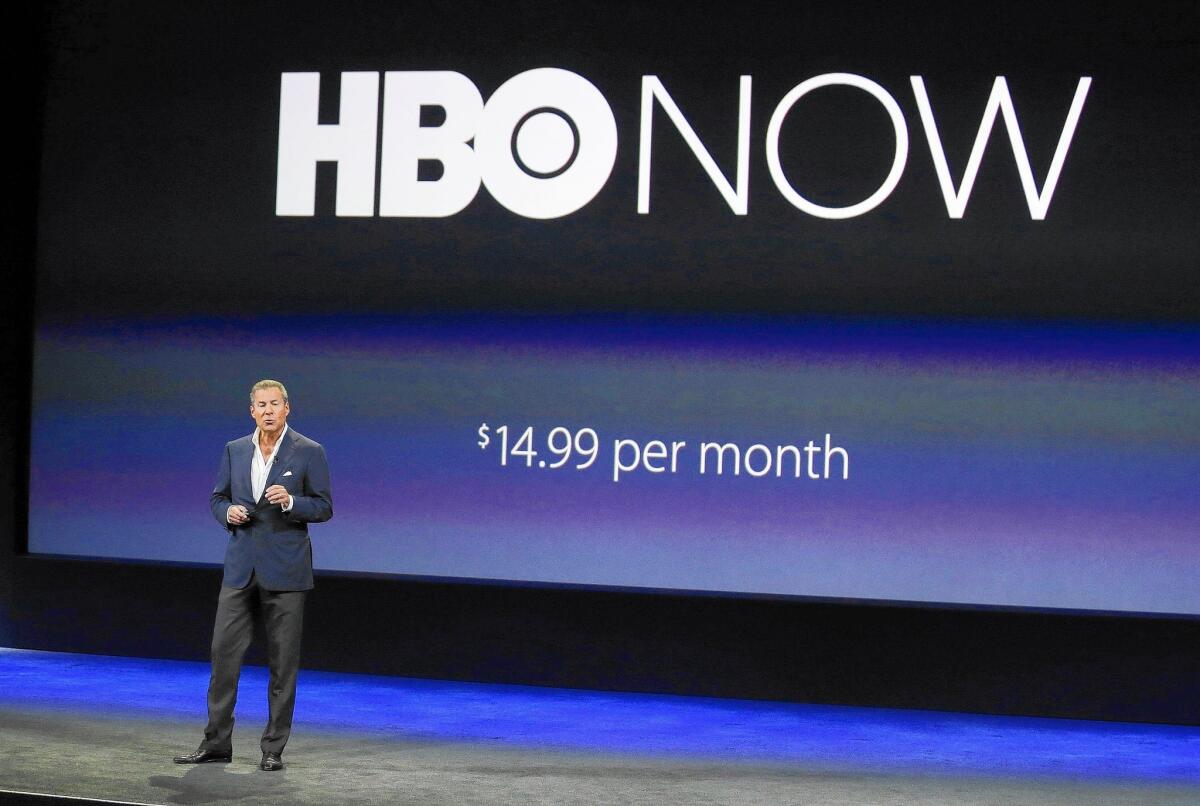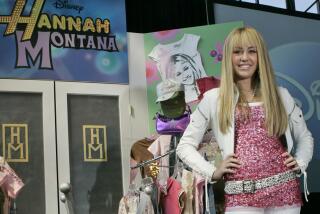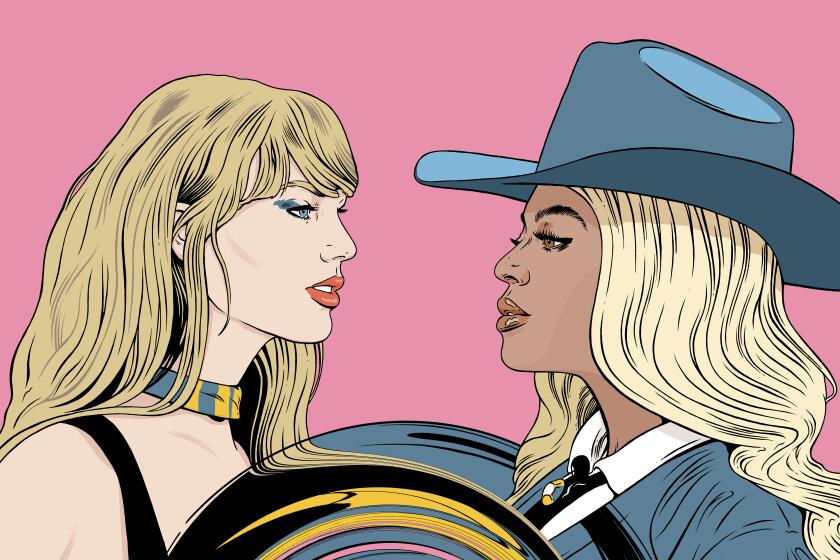A ‘media meltdown’? Disney remark on TV viewing sends industry into tailspin

It’s been two days of harsh reckoning for the entertainment industry as long-simmering concerns about declining pay-TV subscriptions boiled up in quarterly earnings reports, leading investors to dump shares of media stocks amid worries that a key Hollywood money pot is threatened.
The massive sell-off — one analyst called it “the media meltdown” — came after Walt Disney Co. warned investors late Tuesday that profit from ESPN and other cable channels would not be as robust as initially thought because fewer consumers are subscribing to full pay-TV packages.
The sell-off continued Thursday as Viacom disappointed Wall Street with weak sales. Over the last two days, Time Warner slid 10%, Disney shares dropped 11%, Fox fell nearly 13% and Viacom plunged 21%.
Stunning photos, celebrity homes: Get the free weekly Hot Property newsletter >>
“One sentence from Disney and nearly $60 billion in market value gets wiped out,” Doug Creutz, media analyst with Cowen & Co., said Thursday. “Can you say panic?”
It may have been panic, but signs of trouble have been building for more than a decade as the longtime American tradition of gathering in the living room after dinner to watch TV seems to be going the way of bowling leagues and barn dances.
Viewership changes are most dramatic among younger people, the most coveted audience for advertisers. Many are watching TV shows on their tablets and smartphones or recording them for viewing later (and skipping the commercials). That is, if they watch television at all. Sitcoms and police dramas face increased competition from video games, YouTube videos, Facebook, Snapchat and other social media.
Some investors have concluded that owning media stocks is too risky amid dramatic changes in how viewers consume entertainment, analysts said. Viewership changes are beginning to prompt studio chiefs to reassess how they manage their businesses and even which shows and movies get the green light.
“This is exactly what happened to the music industry,” said Jeffrey Cole, director of the Center for the Digital Future at USC Annenberg School for Communication and Journalism. “If you liked two songs you had to spend $16 on a CD. And if you liked three TV channels, you would have to subscribe to more than 100 channels — but now you don’t.”
Fewer people watching TV on a network’s schedule also means a drop in ad revenues, which are based on ratings. This summer, some TV networks struggled to raise prices for their commercial time during the annual ad sales auction. Viacom on Thursday reported that its domestic ad sales had declined 9% in its recently ended fiscal quarter.
All the while, measurement company Nielsen has been struggling to refine its methods to capture viewing on computers, tablets and cellphones, in addition to the TV screen. Media companies contend that measurement gaps have contributed to the lower ratings.
“There is softness in TV ratings, concerns about cord-cutting and concerns about the shift in TV ad dollars to digital platforms,” said Laura Martin, media analyst with Needham & Co. “This is prompting investors to say let’s sit on the sidelines and invest in other stocks that feel safer than media.”
For decades, families had few options if they wanted to watch television shows. They could get a handful of over-the-air broadcast stations or fork over $100-a-month cable or satellite TV subscriptions for access to more than 100 channels, including ESPN, HBO, Fox News, Turner Broadcasting, Animal Planet and Nickelodeon.
But technology has changed that. Consumers have discovered that a high-speed Internet connection is a viable gateway to TV. People under 35, in particular, are used to watching video online, and on their own schedule, and they see less of a reason to sign up for a traditional cable TV package.
YouTube offers millions of videos, including movie trailers, late-night TV comedians cracking jokes and even dogs eating cheese. Streaming services Netflix, Hulu and Amazon.com, which started as an online bookstore, all offer original cutting-edge shows.
This year, Netflix and Amazon are vying for Emmys along with HBO, Showtime, CBS and PBS. Streaming site Hulu now offers “Seinfeld” reruns.
One of the founding fathers of the pay-TV model, HBO, reversed course and now offers a stand-alone $14.99-a-month streaming service called HBO Now. Until this year, viewers who wanted HBO had to pay an extra $15 on top of the cost of a pricey pay-TV subscription.
Although stock value doesn’t directly affect a company’s finances, the shift could have ramifications for Hollywood — particularly if cable programming fees begin to decline. Disney’s acknowledgment, which came during an earnings call late Tuesday, was that its juggernaut ESPN business would be slightly less lucrative than the company had earlier thought.
The admission rattled Wall Street. The thinking was that if the world’s largest entertainment company, Disney, and television’s most profitable channel, ESPN, were not immune, then weaker companies and channels were vulnerable too.
“The market has decided that the cable bundle will fall apart,” said Bernstein Research media analyst Todd Juenger. “But I don’t think that is necessarily so.”
Several media executives, and even some Wall Street analysts, said Wall Street might have overreacted because declines in U.S. pay-TV subscriptions have been small. Researchers have estimated that only about 2% of pay-TV homes have dropped or scaled back their pay-TV packages in recent years, when compared with 2012 levels.
Even so, an eventual dropoff in programming fees from pay-TV companies would be cause for concern. Those fees remain the most reliable and profitable source of revenue for entertainment companies, providing cable channel owners like Disney, Fox, NBCUniversal, Viacom, Time Warner and others with a combined $48 billion a year in revenue.
The industry is aware of the challenge. Pay-TV companies have been trying to adjust to consumers’ demands. In recent months, pay-TV operators, including Dish Network and Verizon, have been touting lower-cost “skinny bundles” with fewer channels. For some consumers, the less-expensive packages have been a potent lure.
Now consumers with a high-speed Internet connection can subscribe to HBO Now, Netflix, Hulu or other Internet-delivered services, including CBS All Access, Showtime and the Tennis Channel. World Wrestling Entertainment has its own streaming product that has attracted more than 1 million subscribers.
The media stock selloff comes as the major TV networks showcase their fall programming to TV writers and critics in Beverly Hills for the twice-annual Television Critics Assn. meetings.
Some executives sought to put a positive spin on the news.
Gary Newman, chairman of Fox Televison Group, noted that his network’s hit show “Empire” prospered despite changing habits.
He pointed out the traditional once-a-week airing of “Empire” helped to generate interest in the drama, which features a dynastic family that owns a record label. Ratings grew each week, and the event-style scheduling also generated social media buzz.
“What ‘Empire’ really speaks to is the fact that broadcast television is still incredibly relevant and vibrant,” Newman said. “But cord-cutting is a phenomenon that I think all media companies need to think about — what is it that’s driving consumers to cord cut?”
Newman and others said their missions haven’t changed.
“On the most simplistic level, our point of view is create content, we’ll figure out some way to get it into the homes and on the mobile devices of consumers,” Newman said. “We’ll be able to figure out a business model that will allow us to continue to do that.”
Ilene Chaiken, an executive producer of “Empire,” agreed.
“I would venture for most writers I know, none of that matters,” Chaiken said. “We’re all about the story. Wherever our work is being seen, whatever technology is distributing or producing it, we’re doing the same thing: We’re telling the very best story we can. And I think you can tell those stories on broadcast TV, on cable, on streaming services — just give me the opportunity to tell my stories.”
Times staff writers Yvonne Villarreal and Ryan Faughnder contributed to this report.
ALSO:
21st Century Fox’s quarterly profit falls, still beats expectations
Disney earnings soar 11%, but changes in TV industry pose risks
DreamWorks Animation loses $38.6 million in second quarter
More to Read
From the Oscars to the Emmys.
Get the Envelope newsletter for exclusive awards season coverage, behind-the-scenes stories from the Envelope podcast and columnist Glenn Whipp’s must-read analysis.
You may occasionally receive promotional content from the Los Angeles Times.








